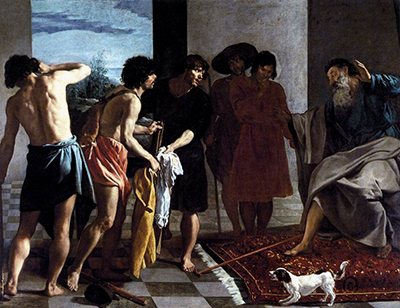Joseph's Bloody Coat Brought to Jacob is one of the paintings to be influenced by Velazquez's first trip to Italy, where he spent a year of his life travelling around the country. Much of the reason behind this trip was his interest in the work of Titian, though he held a strong passion for Italian art more generally as well.
The painting is dated at 1630, and is believed to have actually been painted during his time in Italy. It was later shipped back to Spain and can now be found in the collection of the Monasterio de San Lorenzo, El Escorial. This was an exciting period for the artist, and it was around this point that he also spent time in the company of Peter Paul Rubens, who was also well established at that time and seemed to share some opinions on art with Diego Velazquez. We can find elements within this painting that actually draw different influences together in one piece, whilst also offering us more examples of the Spaniard's own personal innovations that ensured his career was always considered impressive but also unique. Some have also pointed to elements of Tintoretto within this painting as well, such as with the tiled flooring.
Religious themes were not available to Velazquez whilst serving as a court painter within his native Spain, but after arriving in Italy, he suddenly felt both an opportunity and also a desire to try out other ideas. There would be landscapes within the Medici gardens, and then a number of artworks on religious topics. During his first trip to Italy he is believed to have visited Genoa, Venice, Rome and Naples as part of a full year of exploration, as it turned out. The story captured within this painting tells of how Joseph has been placed into slavery and attempts have been made to make it look as if he was actually dead. Jacob, his father, is captured hearing this news and the reaction to it forms the basis of this scene.
The grand location in which this painting can be found on display is in the Royal Site of San Lorenzo de El Escorial where, traditionally, the King of Spain would spend some of his time in residence. It is a treasure trove of historical and valuable art and artifacts from past centuries. Their own art collection features some of the great names of the Renaissance and Baroque eras, including Titian, Tintoretto, Benvenuto Cellini, El Greco, Rogier van der Weyden and Paolo Veronese. The architecture of this site alone is extraordinary, even before you start to study some of the works that are permanently on display in this imposing but stunning venue that is entirely fitting for the King of Spain. Thankfully, much of the site is open to the public for much of the year and those with the opportunity to do so, really should visit this exciting venue.




